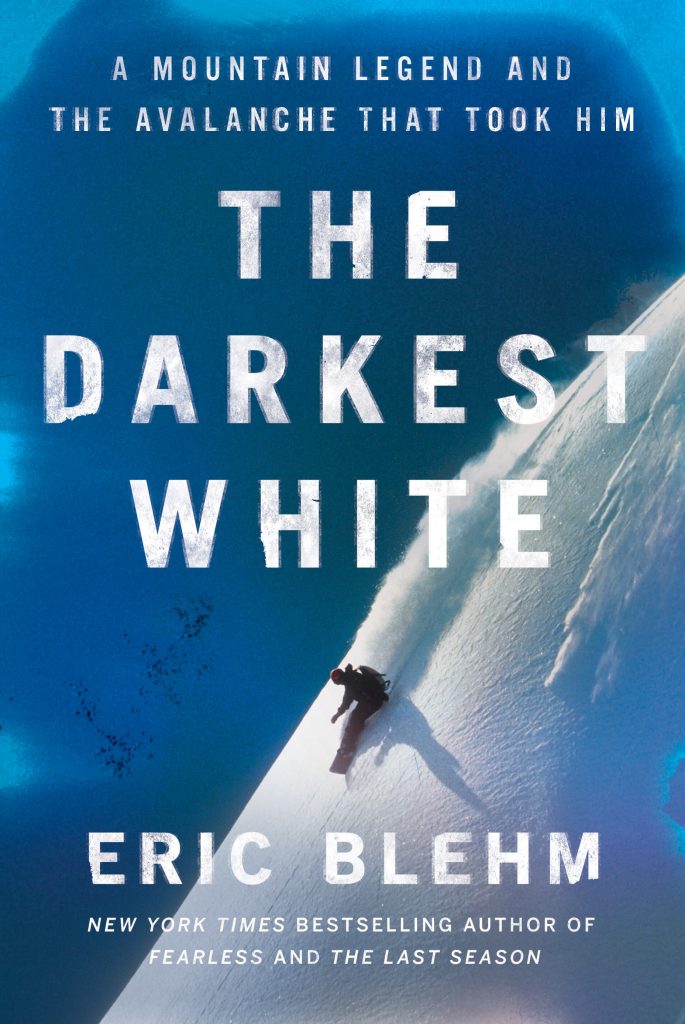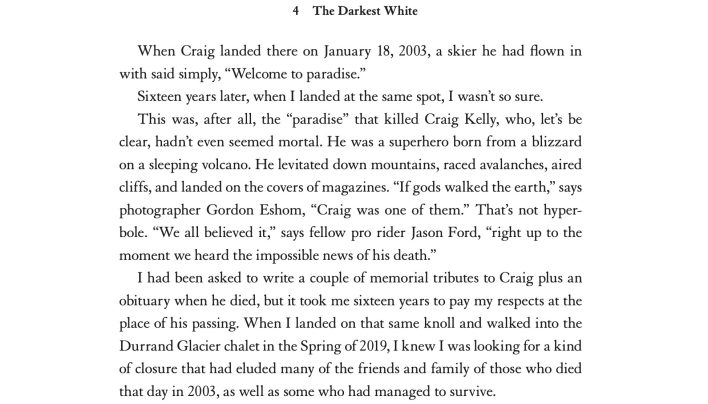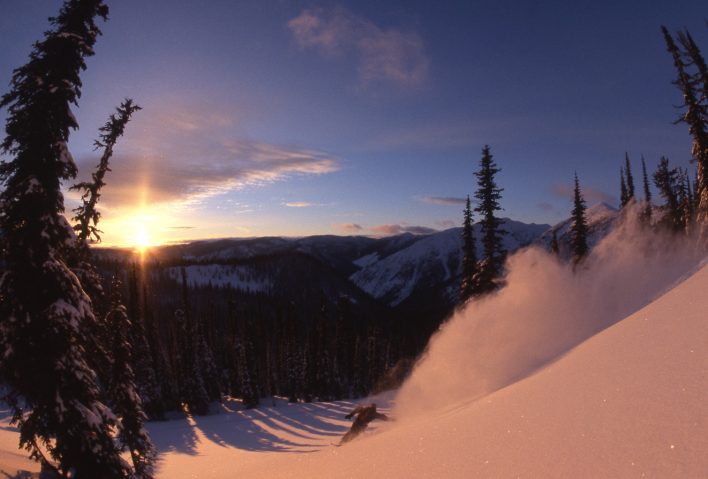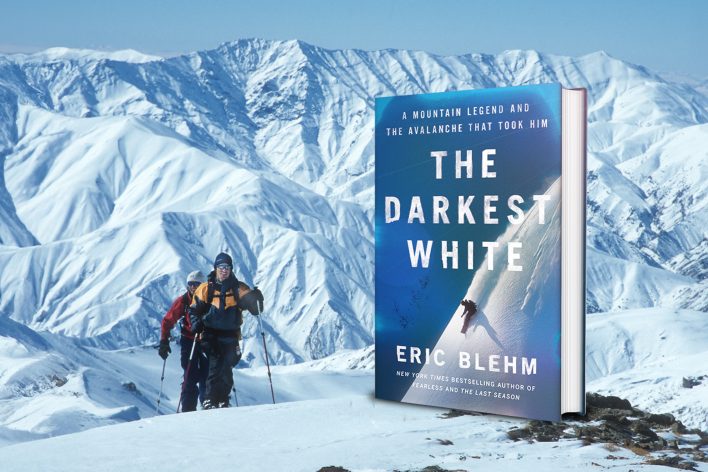Born and raised in southern California, Eric Blehm was captivated by the nascent sport of snowboarding from an early age. With pipedreams of going pro, Blehm found an adjacent, but successful career in journalism. Writing in the 1990s, first for Powder, then Transworld SNOWboarding, where he became editor in chief, Blehm made his way around the world riding and writing about the best of the best, including Craig Kelly. But Blehm’s focus shifted beyond the sport when, in 1999, he became the first journalist to accompany an elite Army Ranger platoon on a training mission. Jumping out of snow sports and into the world of narrative non-fiction, Blehm’s first book, The Last Season (2006) won the National Outdoor Book Award. His work, which focuses on ordinary people in extraordinary circumstances, includes New York Times bestsellers Fearless, Legend and The Only Thing Worth Dying For. Most recently, Blehm returned to the world of snowboarding to write what he considers his magnum opus: The Darkest White. Part biography, part cautionary tale, part man versus nature, The Darkest White brings iconic snowboarder Craig Kelly to life and the avalanche that killed him to light. And I, for one, couldn’t put it down. —Greta Close

Backcountry Magazine: How does it feel to be near the end of this five-year journey?
Eric Blehm: The journey really began, when I was sitting at Craig’s memorial service 21 years ago. That was when I was assigned to write a couple of tributes for TransWorld and Couloir. So it’s really been a 21 year process, five years full on. I gotta tell you, it was really awesome to dive back into the roots of my writing—I became a writer because I wanted to snowboard the world on someone else’s dime.
After being on staff at TransWorld, I went freelance and got into writing adventure outdoor stories, then I segwayed into military nonfiction, telling the stories of those who serve. That is something that I wanted to do after 9/11 because I just felt that as a journalist, what was my part? I had never served my country at a time when I could have …. But I thought I can tell the stories. So many veterans from the World Wars never spoke of their experiences. This was my generation, and history was happening, I wanted to preserve the stories, tell it like it happened from those on the ground. In a way I feel like all these stories that I wrote about special operations forces, and missions were training to come back and tell this story, which I tend to think of as my opus, telling Craig Kelly’s story.
Now that I finally finished it, I feel two things. First of all, because it was a really difficult story to write, I would tell my closest friends that I felt like I just got out of prison. I had a lot of weight on my shoulders. I’m bringing up things that have never been told before regarding the avalanche [that killed Craig] and I have the weight of the legacy of this iconic hero to a whole generation of snowboarders including myself.
And now that it’s done, especially getting the feedback, I’m really excited because I feel like [this book] is going to introduce Craig Kelly to a whole new generation who would have never known who he is before, so I’m really, really excited about that.

BCM: Where do you begin with a project like this?
EB: I knew Craig. I consider him a friend, not a buddy, like his buddies from [growing up], but I knew him and so I was able to pull from my own memories. Also, as far as the history of the sport—I was in that early first-generation wave of snowboarders.
I wanted it to be Craig’s story, but I wanted to weave his life throughout the history of snowboarding’s golden age. I knew from the beginning it was part biography, part history and part disaster narrative, like a Perfect Storm—only its mountains and avalanches, and snow science. So, really it’s three books in one.
It took me 10 months just to write the proposal. In that you’re kind of telling the whole story arc, and describing your research, being confident, but honest. “Hey, am I gonna be able to talk to the survivors? Am I going to be able to talk to Rudy Beglinger, the lead guide, or Ken Wylie, the assistant guide?” I have a track record, so I provided a list of who I thought I’d be able to speak to, with a few confirmations and then you hope for the rest. Well, at the end of the day, I was able to speak to nearly every survivor—almost everybody who was physically in the whole [accident].
As for Craig’s biography. My basic strategy in any story, and this one especially is to tell the story from Craig’s perspective, and the perspective of people who were touched by Craig. Some people call it narrative nonfiction, but it’s really narrative journalism, because I work in a lot of quotes and other people’s words to tell the story and try and weave it together in a way that brings Craig to life on the page.

BCM: Chapter 1 starts with Sherman Poppen and the creation of the Snurfer. Why there?
EB: I started [the book] where I did because I wanted to introduce the general reader who doesn’t know snowboarding, doesn’t know Craig really, at the beginning [of the sport]. I don’t think a lot of people [who] see the crazy Olympics and X Games exhibition events that everybody loves to watch—they really have no idea where [the sport] came from.
When you really start looking into snowboarding, the history, it gets muddy. But I could definitively, trace back to Craig’s first board—it was a Burton Backhill. From the Backhill, you trace it back to Jake Burton Carpenter and his first inspiration was the Snurfer, which took me to Sherman Poppen, Christmas morning, 1965.
I knew Craig was born April 1, 1966, and so I dug and found that Sherman Poppen applied for the patent for the Snurfer exactly two weeks before Craig was born. In his patent application, Poppen described the Snurfer … would create a new sport … a winter evolution combining elements of surfing, skateboarding and he even says wind surfing. To me that was so prophetic. He didn’t even know that he had foretold the future of an entire new mountain subculture. And that subculture’s first real superstar, the one who became the very first icon, [Craig Kelly], was born two weeks after he filed that document—that sealed it for me, that was why I started the book where I did.
BCM: We often consider magazines as a record, in our case it’s for backcountry skiing. But reading the book, it’s clear how the same was true of snowboarding. What does this book mean to you, to the sport of snowboarding?
EB: A lot of the quotes and things I use in the book are taken directly from the history books of the sport, meaning the very first snowboarding magazines.
As a whole, The Darkest White is an homage to the magazines that were so important to all of us, and I love that you picked up on that! I’m really honored to have been not only a part of it, but you’ll see in the notes that I thank every single person who ever contributed to either a snowboarding magazine or a video, who unknowingly documented the history of the sport, probably just because they wanted to ride pow.
There’s a lot of books that kind of show the basic history of snowboarding, and there’s ones that talk about individual people’s memoirs, but I don’t think anyone’s ever done one where you where you thread someone’s life story and death into the chronology of the history of snowboarding.
You know, for me, snowboarding gave me a path in life. So I owe a lot to snowboarding. I owe a lot to Transworld publications, and the sport and people like Craig. What an honor to be able to share adventures, and meet likeminded souls during those winters, but then now, years later honored so many people were not only willing but excited and happy to take part and help me to put this story together. For Craig, really, but also for that life snowboarding has given us.
BCM: In your tribute to Craig, “The Gatekeeper,” who write:
“After dinner that night, Craig asked if I thought the world was ready for a book about a snowboarder, and I replied, ‘You want to write a memoir?’ ‘Maybe,’ he said, ‘I’ve been journaling, keeping track of my dreams, and I’ve been thinking maybe it’s time to tell some of my stories’ … Then he said, ‘Maybe you could help me out?’ I was flattered, because not only was Craig a longtime snowboarding hero of mine, he was also one of the few snowboarders I felt really had something to say. ‘When you’re ready,’ I told him, ‘I’d be honored to help out in any way you’d like.’” —Eric Blehm, “The Gatekeeper”, TransWorld SNOWboarding, Sep. 26, 2003.
How does it feel to be on the other side of writing a book about his life?
EB: First of all, Craig and I, our connection, we both loved the backcountry and … we both were big readers. We loved books. One of the first things either of us would say on a trip was, “Hey, what are you reading?”
When he brought up the idea of writing his own story, his engineering mindset really shined through, his cerebral, thoughtful way of approaching any problem. He’d say, “What do you think about first person versus third person? Like in books? And people that would write a book about somebody or a memoir,” and then from that he said, “Do you think it’s cool when it’s in past tense, or sometimes people will write in the present tense,” he’s like, “That’s kind of funky because even though it’s really immediate, it’s kind of weird, because you know, you’re reading it and you know, it’s not happening right now.” And so he had an issue with that … then he said he was gonna sleep on it. Well, the next morning, when we were walking down to breakfast from this hotel up in the Alborz mountains of Iran, he said, “You know, I want to write my story, but the time is not right. It’s not time yet.” And then he looked at me, he had this mannerism, that people who know Craig will recognize, he’d kind of lift his chin up, kind of give you a sideways glance. He just looked at me and he said, “You know, people don’t really want to read about you until you’re dead.” Then he just said, “Fuck that.”

BCM: Can you talk about the title in more detail?
EB: The very first article I ever had published was in Powder magazine, back in I believe winter ‘92/93. It was called “The Darkest White.” That was my very first and it was about an avalanche survival story … somebody there [at Powder] titled it. I thought it was such a great metaphor for an avalanche. It’s dark, it’s gnarly, it’s evil, but it’s also this snow, this lovely, beautiful, fluffy white snow that shapes our lives.
When Craig passed away, at that time, I think, it was the darkest day in snowboarding’s history. And he was like a shining light. It was the darkest white, but he was the shining light, if that makes sense? Some people interpreted it like the white whale, chasing that obsession.
BCM: Part III of the book is titled “The Avalanche”. This was of course a tragedy, but also a controversial incident. Why did you choose to have that as such a focus of the book?
EB: The build up to the avalanche and his journey to become a guide were important to me for a couple of reasons. One is that Craig was so well documented in his early years of snowboarding—people can find that, it’s documented. But those last couple years of his life, he only did like one or two interviews so there was this gap I wanted to fill. During that period, he was breaking ground for snowboarders as the first splitboarder accepted into the Association of Canadian Mountain Guides certification process. I really wanted people to understand how much schooling went into that and how much training went into that and then to show that even with all of that, you can get caught up in this slip stream and still get into trouble.
This is a cautionary story, and I want people to learn from it, and the details matter.
I also felt that honestly, the avalanche, it killed seven people, and I found many of the survivors still had questions. Even after the independent investigation, the coroner’s investigation or report, and then even the assistant guide, his memoir, which, of course is his perspective. Something just didn’t feel right, there was more to the story. I felt in order to build up to the ultimate day of the avalanche, you needed to know what led up to it. So it really happened organically, that part of the story grew as the research presented itself.
As you read it various people in that group had their own thoughts about their route, about that day and they’d never shared what they were feeling. Their honesty was a gateway. I always love it when you can have multiple perspectives of a single event, and you can piece together where things intersect. That’s where I think you can find the closest thing to the truth.

BCM: Do you see changes between when the avalanche occurred and now, in how the backcountry is addressed?
EB: I will say that I do think that a lot has changed, but I’m not a working avalanche forecaster, guide or professional. But I spoke to dozens of them. It seems the consensus is yes, a lot has changed, but at the same time, a lot has remained the same in the decision making in the backcountry—the challenges, the human factor, is one thing that still is, and I think will forever be the issue because humans are human. They’re always gonna be battling themselves and their own ego and their own stoke, honestly. I mean, fresh powder is so benign and so inviting and so beautiful, and it seems so gentle and safe. But we know what can happen. That said, communication, and open communication has definitely improved. Evolved.
BCM: What do you hope is the main takeaway for readers regarding the avalanche, the dark part of the story. Is there light?
EB: Craig is the light. Some people will pick this book up because they want to read about the disaster, but in the process they’re going to get to know Craig. That is my overall goal. But in regards to the end of the book, the avalanche is its own central character, in a way. I hope that the story, as raw as it is, that those who read it will always think about what can happen when they’re out there poised to either drop in on something or climb up something and ask themselves, “If Craig had a second chance, what would he do right here, right now?” That part, that positive reflection I hope the book inspires, will make people think, “Is this run worth dying for?” And, “Is there another option that will still give me a great adventure and some awesome turns?” If you’re a gambling man or woman, just remember nature always wins.
The Darkest White is now on sale. Visit Blehm’s website to order a copy, or to learn more about his other work. He can also be found on Instagram, @ericblehmofficial, and on the latest episode of the Backcountry Magazine Podcast.










Related posts: